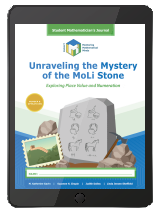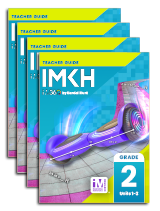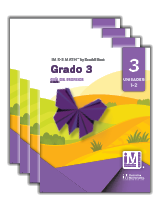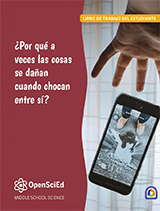Search Listing Name

product:
Project M3: Level 3-4: Unraveling the Mystery of the MoLi Stone: Exploring Place Value and Numeration Student Mathematician's Journal 1 Year License
The Student Mathematician’s Journal allows students to explore simulated or real-life problems and help them to think, write, and read like mathematicians. It encourages students to reflect on what they have learned in each lesson, think deeply about mathematics, and communicate in writing on worksheets.
In this unit, students explore our numeration system in depth. Students begin by looki
product:
Project M3: Level 5-6: Record Makers and Breakers: Analyzing Graphs, Tables and Equations Teacher Text + 3 Year Online License
In this unit, students learn about algebra as a set of concepts tied to the representation of relationships either by words, tables or graphics. They extend their notion of variable from a letter in an equation that represents a number to a more broad definition, that of a quantity that varies or changes. Students also study constant and varying rates of change as an intuitive introduction to slope.
The
product:
Mind Over Matter: Exploring Critical Thinking Skills
This curriculum is designed to collect data, analyze data, search for the truth, and think for themselves. This curriculum is also designed to support the social and emotional needs of today’s teen. Socially, this curriculum helps students and teachers build relationships with specifically designed interactions, activities, and lessons. Positive social interactions require healthy relationships. This curriculum is designed to get students talking to one another by using strategies targeting teamwork, collaboration, compassion, and empathy. Emotionally, students learn strategies to talk abou

product:
IM v.360: Grade 2 Teacher Guide Set
IM® v.360 K-5 Math is an IM Certified curriculum providing trusted, highly rated materials to ensure students thrive in mathematics. Each Illustrative Mathematics lesson has four phases, from pre-unit practice modules to cool downs, focusing students’ attention on definitions, notations, and graphical conventions contributing to the development of real numbers.
Grade 2
The big ideas in grade 2 include: extending understanding of the base-ten number system, building fluency with addition and subtraction, using standard units of mea

product:
Illustrative Mathematics: Grade 3 Spanish Student Edition Set
Illustrative Mathematics K-5 MathTM is an IM Certified product providing trusted, highly rated materials to ensure students thrive in mathematics. Each Illustrative Mathematics lesson has four phases, from pre-unit practice modules to cool downs, focusing students’ attention on definitions, notations, and graphical conventions contributing to the development of real numbers.
The big ideas in

